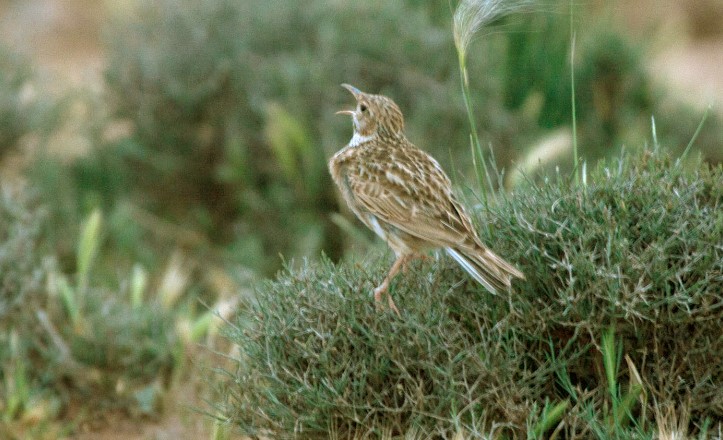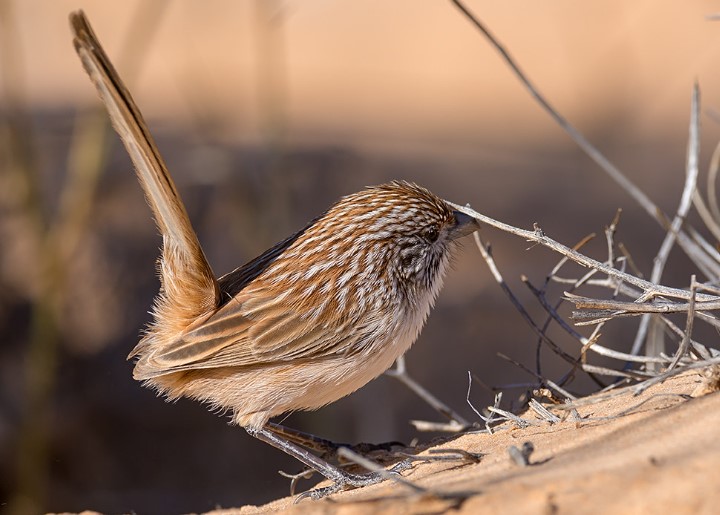Family: Dupont’s lark (Chersophilus duponti) is a shy and elusive species of arid plains with sparse vegetation. This is a monotypic species of Chersophilus in the family Alaudidae.
Habitats: everywhere described as uncommon or scarce but overlooked due to shyness. Recently, it was found to be relatively widespread in relict patches of suitable breeding habitat in the arid steppes of northeast Spain, where few records have been found for several decades. This lark breeds in Portugal in addition to its mapped range.
Larks prefer dry steppes with feather grasses and low Artemesia shrubs. Furthermore, it favors semi-deserts with well-vegetated, semi-bare areas flanked by clumps of vegetation. Larks tend to cultivate and stubble with other larks after breeding.

Identifying characteristics: This bird is a fairly large, elegant lark with long legs and a long, slightly decurved bill. Running with the body horizontal and the bill slightly raised, with a relatively small but bulbous head on a slim, long neck. Despite the heavily streaked plumage, the upper parts are heavily mottled with whitish spangles between the dark streaks (streaks are rufous in eastern races). The streaking above forms a wide breast band that contrasts with the whitish lower underparts.
The Dupont’s lark is very difficult to find in spite of its distinctive appearance. In order to conceal itself from predators, it stays close to low cover and runs quickly on its hind legs, preferring to hide behind vegetation rather than fly. It is shy and wary and prefers to stay close to low cover. In the daytime, it is particularly difficult to locate because it is most active at dawn and dusk. During the flight, the wings appear broad and rounded, and the tail feathers are white.
The most likely confusion is with long-billed North African races of the Crested Lark (Galerida cristata), but the latter is bulkier, with buff outer tail feathers, and lacks streaked or mottled upperparts; the crest is usually obvious but can be absent during molt, and there is no sign of the pale median crown-stripe typically seen in Dupont’s.
Race margaritae (Algeria to Egypt) appears to have a shorter tail than the nominate race (although the tail looks rather narrow). Visiting breeding areas at dawn and dusk is the best way to locate this elusive bird. The juvenile Tawny Pipit has a much shorter bill than the adult.
Nest or Eggs: A Dupont’s lark lays its three or four eggs; usually nests are found on the ground.
Diet: Seeds and insects are the main components of the diet.
Sex/Age: Almost unstreaked above, the juveniles have pale feather fringes and dark feather centers on their upper parts.
Call: Dupont’s lark calls infrequently but are characterized by a fluty whistle and a nasal ‘hoo-ee’.
Song: In flight, the song of Dupont’s lark is distinctive. Almost alternately flapping its wings, it rises high and hangs for a while before dropping like a stone to the ground. Whether singing in flight or perched, the song consists of a few sweet, clear, thrush-like notes followed by a penetrating, nasal, rising ‘djeeeee.’ It is this latter part that is most audible. Standing on the edge of a low bush, this shy bird can be heard calling.
Geographical Variation: There is a noticeable difference. The two races are different. The nominate race (Spain, Morocco, and C Tunisia) is streaked dark brown.
Races: The margaritae (Algeria south of the nominate race to Northwestern Egypt) has rufous streaks and shorter tails.







